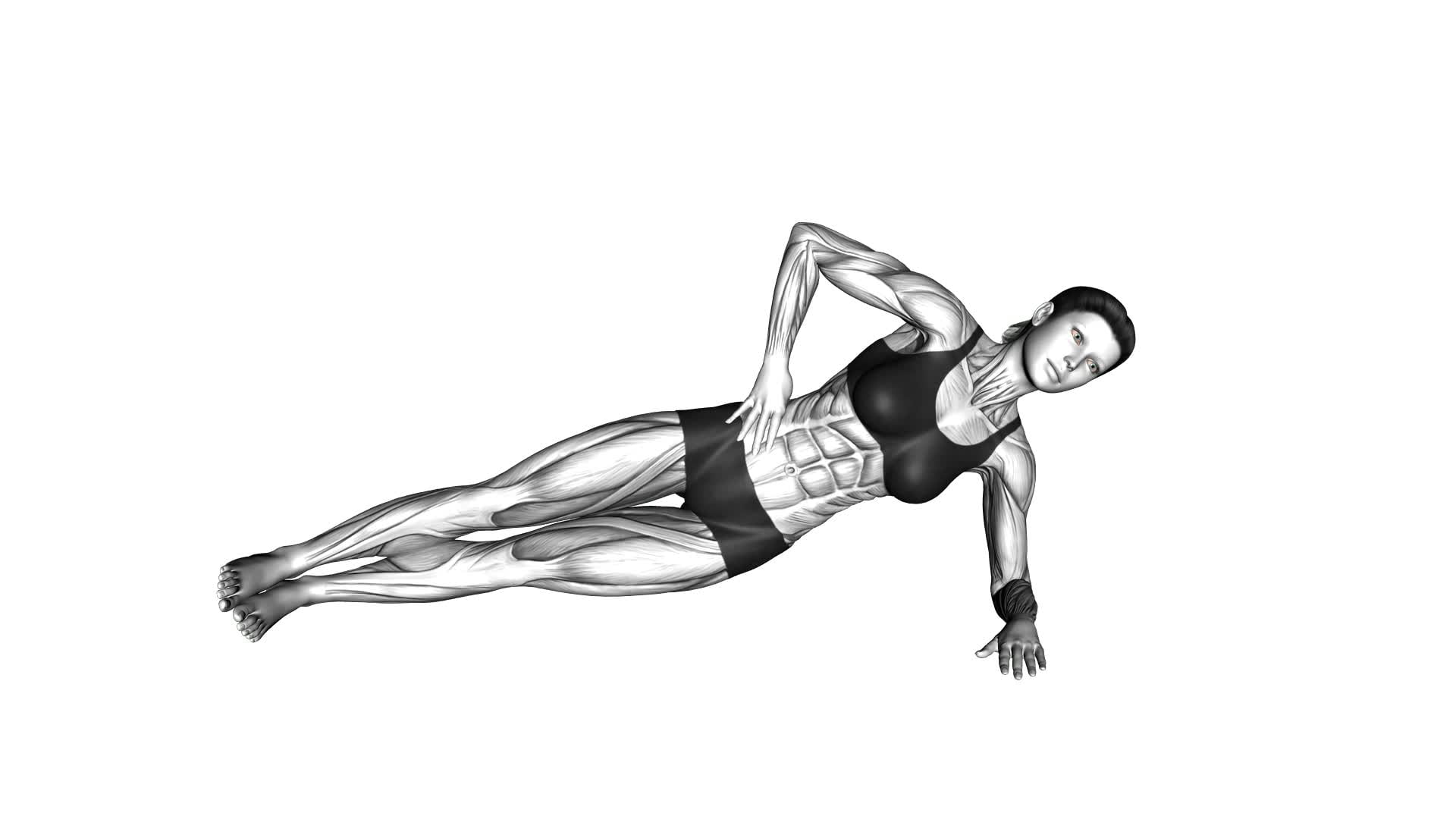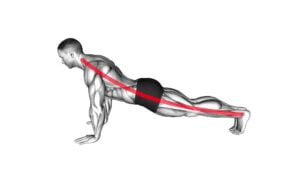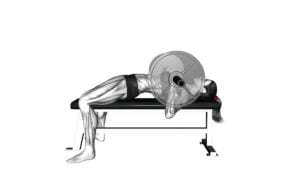Side Plank – Butt (WRONG RIGHT) (female) – Video Exercise Guide & Tips

Are you looking to tone your butt muscles and improve your side plank exercise?
Watch This Exercise Video
In this video exercise guide, we'll show you the common mistakes to avoid, proper form for side plank, and how to engage your glutes effectively.
We'll also provide variations specifically designed to target your butt muscles and share tips for improving your overall side plank performance.
Whether you're a beginner or advanced, this guide has got you covered.
Let's get started!
Key Takeaways
- Proper form is essential in side plank to avoid common mistakes and ensure effectiveness of the exercise.
- Engaging core muscles and aligning hips are important for stability and to prevent strain on the lower back.
- Glute activation techniques can be incorporated to target the butt muscles and improve posture.
- Female-specific tips include engaging pelvic floor muscles, modifying the exercise to prevent strain, and maintaining neutral spine alignment for shoulder health.
Common Mistakes in Side Plank
You may be making some common mistakes in your side plank exercise. One of the most important aspects of the side plank is maintaining the correct hip position. It's common to see people allowing their hips to sag or hike up in this exercise, which can put unnecessary strain on the lower back and diminish the effectiveness of the exercise. To avoid this mistake, make sure to keep your hips in line with your body, forming a straight line from your head to your heels.
Another common mistake to watch out for is improper shoulder alignment. Many people tend to let their shoulder collapse or rotate forward during the side plank, which can lead to shoulder pain and instability. It's crucial to keep your shoulder stacked directly over your elbow, ensuring that your upper body is stable and supported.
Proper Form for Side Plank
To perform a side plank with proper form, you have two options for supporting your upper body: your elbow or your hand.
Make sure to align your hips so that they're stacked on top of each other, and avoid letting your top hip drop towards the ground.
Engage your core muscles throughout the exercise to maintain stability and maximize the benefits of the side plank.
Elbow or Hand
For proper form in the side plank exercise, start by choosing whether to support yourself on your elbow or hand. Both options have their benefits and it ultimately comes down to personal preference.
When supporting yourself on your elbow, it provides more stability for your elbow joint and can be easier on your wrists. This position also engages the muscles in your shoulder more, promoting shoulder stability and strengthening.
On the other hand, supporting yourself on your hand challenges your wrist stability and engages the muscles in your forearm. It also requires more core and shoulder strength to maintain the proper alignment.
Whichever option you choose, make sure to keep your body in a straight line from head to toes and engage your core for maximum effectiveness.
Hip Alignment Tips
Achieving proper hip alignment is crucial for maintaining proper form in the side plank exercise. To ensure your hips are properly aligned, start by lying on your side with your legs straight and stacked on top of each other.
Place your elbow directly beneath your shoulder, keeping your forearm perpendicular to the ground.
Lift your hips off the ground, creating a straight line from your head to your heels. Engage your core and squeeze your glutes to maintain stability.
It's important to focus on your breathing throughout the exercise, inhaling deeply through your nose and exhaling fully through your mouth.
Proper breathing techniques can help you maintain control and prevent hip injuries.
Engaging Core Muscles
Maintain stability and maximize the effectiveness of your side plank by engaging your core muscles throughout the exercise. Here are some tips to help you engage your core muscles and improve your core stability during side plank:
- Start by lying on your side with your forearm on the ground, elbow directly under your shoulder.
- Engage your abdominal muscles by drawing your belly button in towards your spine.
- Squeeze your glutes to create a stable base.
- Keep your body in a straight line from your head to your heels.
- Avoid letting your hips sag or rotate during the exercise.
- Breathe deeply and maintain a steady contraction in your core muscles throughout the entire exercise.
By engaging your core muscles, you won't only improve your core stability but also enhance the effectiveness of the side plank exercise.
Now, let's move on to the next section about engaging your glutes in side plank.
Engaging Your Glutes in Side Plank
To effectively engage your glutes in side plank, there are several key points to keep in mind.
First, focus on glute activation techniques such as squeezing your glutes throughout the exercise.
Second, ensure proper hip alignment by stacking your hips on top of each other and avoiding any sagging or tilting.
Lastly, emphasize the synergy between your core and glutes by maintaining a strong and stable core while actively engaging your glutes.
Glute Activation Techniques
Engage your glutes for optimal results in the side plank exercise. Activating your glutes not only helps to stabilize your body during the exercise but also enhances the overall strength and functionality of your glute muscles. Here are three glute activation techniques to incorporate into your side plank routine:
- Clamshells: Lie on your side with your knees bent and feet together. Open your top knee while keeping your feet together and squeeze your glutes at the top of the movement.
- Glute bridges: Lie on your back with your knees bent and feet flat on the ground. Lift your hips off the ground, squeezing your glutes at the top and holding for a few seconds before lowering back down.
- Fire hydrants: Start on all fours with your hands directly under your shoulders and knees under your hips. Lift one knee out to the side while keeping your core engaged and squeezing your glutes.
Incorporating these glute activation exercises into your side plank routine won't only improve your performance but also provide the benefits of strong glutes, such as improved posture and reduced risk of injury.
Proper Hip Alignment
To ensure proper hip alignment and engage your glutes in the side plank exercise, focus on keeping your core stable and your hips lifted. Proper hip alignment is crucial for maximizing the benefits of this exercise and preventing injury. Many people make the mistake of sagging their hips or letting them drop forward, which reduces the activation of the glute muscles.
To avoid this, imagine creating a straight line from your head to your heels, with your hips slightly lifted. Engage your glutes by squeezing them throughout the exercise. Additionally, proper breathing techniques can enhance your performance. Take deep breaths in and out, inhaling through your nose and exhaling through your mouth. This will help you maintain stability and engage your core more effectively.
Core and Glute Synergy
Maintain a stable core and lift your hips to engage your glutes in the side plank exercise, ensuring proper alignment and maximizing the benefits of the workout. To activate your core and glutes effectively during side plank, follow these tips:
- Squeeze your glutes: Focus on contracting your glute muscles to lift your hips off the ground. This will engage your glutes and help stabilize your body in the side plank position.
- Engage your core: Keep your core muscles engaged throughout the exercise by pulling your belly button in towards your spine. This will provide additional stability and support to your body.
- Progress gradually: Start with a basic side plank and gradually progress to more challenging variations, such as lifting the top leg or adding a side plank with a twist. This will further engage your glutes and challenge your core muscles.
Variations to Target Your Butt Muscles
Try incorporating these variations into your workout routine to specifically target your butt muscles.
Adding different exercises to your routine can help activate your glutes and enhance the benefits of side plank for your glutes.
One variation you can try is the Side Plank Leg Lift. Start by getting into a side plank position, with your elbow directly beneath your shoulder and your body in a straight line. Lift your top leg up while keeping it straight, and then slowly lower it back down. This exercise targets your gluteus medius, which is responsible for stabilizing your hips.
Another variation is the Side Plank Hip Dip. Begin in a side plank position, with your elbow directly beneath your shoulder and your body in a straight line. Lower your hip towards the ground, and then lift it back up. This movement targets your gluteus maximus, which is the largest muscle in your butt.
Incorporating these variations into your workout routine can help you specifically target your butt muscles and further activate your glutes. Remember to focus on proper form and engage your core throughout the exercises.
Tips for Improving Your Side Plank
Are you struggling to maintain proper form and engage your core during the side plank? Improving stability and getting the most out of this exercise can be challenging, but with a few tips and modifications for beginners, you can enhance your side plank and reap its benefits.
Here are some suggestions to help you improve your side plank:
- Focus on alignment: Make sure your body is in a straight line from head to toe. Engage your core muscles and avoid sagging or arching your back.
- Start with a modified version: If you find the traditional side plank too challenging, begin by doing a modified side plank on your knees. This will help you build strength and stability before progressing to the full version.
- Use props for support: Placing your bottom knee or forearm on a folded towel or yoga block can provide extra support and stability, especially if you have wrist or shoulder issues.
By following these tips, you can enhance your stability and make progress in your side plank.
Now, let's explore some female-specific tips for side plank to further improve your form and maximize the benefits of this exercise.
Female-Specific Tips for Side Plank
To optimize your side plank, incorporate these female-specific tips for improved form and effectiveness.
Side plank is a highly beneficial exercise for women, as it targets the core, obliques, and glutes.
To modify the side plank for women, you can start by positioning your feet slightly wider apart for added stability. This modification can help prevent strain on the hips and lower back.
Additionally, engaging the pelvic floor muscles while performing the side plank can provide extra support for the pelvic area, which is especially important for women.
Another modification is to place your top hand on your hip instead of reaching it towards the ceiling. This can help maintain a neutral spine alignment and prevent excessive strain on the shoulder joint.
Frequently Asked Questions
How Many Calories Can You Burn by Doing Side Planks?
To answer your question about how many calories you can burn by doing side planks, it's important to note that the number of calories burned during exercise varies from person to person.
However, side planks are a great way to engage your core muscles and can contribute to overall calorie expenditure. If you're a beginner, there are variations of side planks that can help you build strength gradually.
Additionally, incorporating side planks into a full body workout routine can enhance the calorie-burning potential.
Can Side Planks Help Reduce Cellulite in the Butt Area?
Side planks can be an effective exercise for reducing cellulite in the butt area. They target the muscles in the buttocks, helping to strengthen and tone them.
While squats are also beneficial for reducing cellulite, side planks offer a unique challenge that engages the muscles from a different angle.
Is It Normal to Feel Pain in the Shoulders While Doing Side Planks?
Feeling shoulder pain during side planks isn't uncommon. It's important to listen to your body and make modifications if needed.
To alleviate the discomfort, try adjusting your hand placement or using props like a yoga block for added support.
Remember to engage your core and keep your body aligned to prevent straining your shoulders.
If the pain persists or worsens, it's advisable to consult a fitness professional or healthcare provider for guidance.
Can Side Planks Lead to a Smaller Waistline?
Side planks are a great exercise for toning your waistline. By engaging your core muscles, side plank variations can help strengthen and define your obliques, leading to a smaller waistline over time.
To get the most out of your side planks, it's important to maintain proper form and alignment. Find the best time to do side planks that works for you, whether it's during your workout routine or as a standalone exercise.
Are There Any Specific Breathing Techniques to Follow During Side Planks?
During side planks, it's important to focus on your breathing. Take deep breaths in and out, inhaling through your nose and exhaling through your mouth. This will help you maintain proper form and engage your core muscles effectively.
Incorporating side planks into your workout routine can have numerous benefits, such as improving your core strength, stability, and posture. Remember to listen to your body and take breaks if needed, but challenge yourself to hold the position for longer durations over time.
Conclusion
In conclusion, mastering the side plank exercise is crucial for targeting and strengthening the glute muscles. By avoiding common mistakes and maintaining proper form, you can effectively engage your glutes and achieve optimal results.
Additionally, incorporating variations and following the provided tips will help you improve your side plank and maximize its benefits.
Whether you're a female or male, this exercise is a great addition to your fitness routine to sculpt and tone your butt muscles.

Author
Years ago, the spark of my life’s passion ignited in my mind the moment I stepped into the local gym for the first time. The inaugural bead of perspiration, the initial endeavor, the very first surge of endorphins, and a sense of pride that washed over me post-workout marked the beginning of my deep-seated interest in strength sports, fitness, and sports nutrition. This very curiosity blossomed rapidly into a profound fascination, propelling me to earn a Master’s degree in Physical Education from the Academy of Physical Education in Krakow, followed by a Sports Manager diploma from the Jagiellonian University. My journey of growth led me to gain more specialized qualifications, such as being a certified personal trainer with a focus on sports dietetics, a lifeguard, and an instructor for wellness and corrective gymnastics. Theoretical knowledge paired seamlessly with practical experience, reinforcing my belief that the transformation of individuals under my guidance was also a reflection of my personal growth. This belief holds true even today. Each day, I strive to push the boundaries and explore new realms. These realms gently elevate me to greater heights. The unique combination of passion for my field and the continuous quest for growth fuels my drive to break new ground.







